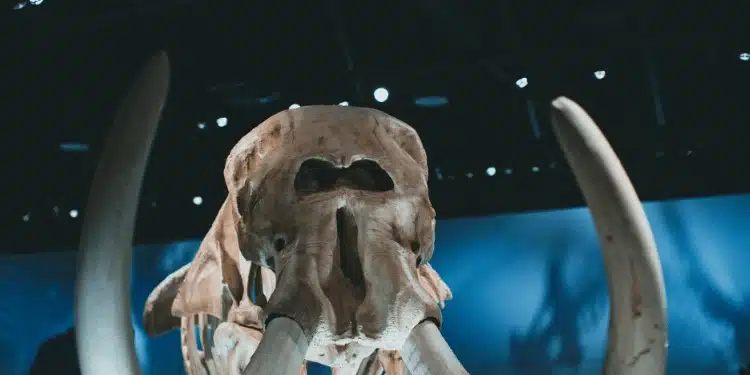Perfectly Preserved Baby Mammoth Discovery: Scientists Unlock Ancient DNA Mysteries in Russian Lab
A Remarkable Discovery in Siberian Permafrost
Yana’s Discovery and Preservation State
Yana, a baby mammoth estimated to be over 130,000 years old, was unearthed in Siberia’s permafrost region.
The discovery was nothing short of extraordinary, revealing a specimen in an exceptional state of preservation.
Excavated from the Yana River Basin, she retained remarkable physical characteristics that painted a vivid picture of her life and times.
Notable Physical Features
These characteristics made her a tangible link to a bygone era, providing scientists and paleontologists with an opportunity to study a creature from the ancient past in incredible detail.
Size and Weight Specifications
Yana measured about 1.2 meters at the shoulder and weighed approximately 180 kilograms, highlighting her stature as a young but hefty calf.
Such dimensions underscored the robustness of mammoths at a young age and suggested the powerful physiognomy they possessed even from early life stages.
Unlocking Insights from Preservation
The preservation of Yana’s physical state was largely attributed to the Siberian permafrost, which acts like a natural freezer, protecting tissues and other biological materials from decay.
This natural preservation implies that much could be learned from her remains, sparking excitement in the scientific community for potential revelations that could arise from a detailed study.
As scientists continue to explore Yana’s remains, the hope is to uncover deeper insights into her life, environment, and the possible causes of her death.
This marks the beginning of a journey not only into Yana’s past but also into understanding more profound biological and environmental questions that her preservation might help answer.
Unprecedented Scientific Investigation
The discovery of Yana, a 130,000-year-old baby mammoth, has initiated an unprecedented scientific investigation at the Mammoth Museum in Yakutsk.
A dedicated team of scientists dressed in sterile bodysuits, goggles, and face masks is working diligently to uncover the secrets hidden within this remarkable find.
Their work involves detailed necropsies, utilizing an array of specialized tools and techniques.

Unprecedented Scientific Investigation
The discovery of Yana, a 130,000-year-old baby mammoth, has initiated an unprecedented scientific investigation at the Mammoth Museum in Yakutsk.
A team of scientists, donning sterile bodysuits, goggles, and face masks, diligently works to unravel the secrets of this extraordinary specimen.
Their meticulous efforts involve a detailed necropsy, employing advanced tools and techniques to ensure precision in sample collection.
Detailed Necropsy
The necropsy of Yana is akin to a window into the prehistoric past.
The scientists, working with surgical precision, aim to preserve the integrity of the baby mammoth’s well-preserved internal organs, including the digestive tract and stomach.
This aspect of preservation is crucial as it facilitates a comprehensive analysis of Yana’s biological makeup and her environment.
Specialized Techniques
To achieve this, the scientists use specialized instruments to carefully collect tissue samples from various parts of Yana’s body. With each incision, they gather invaluable biological data trapped in time.
These samples hold the promise of unlocking secrets about the ancient microorganisms that called Yana’s body home over a millennium ago.
Additionally, tissue samples from the digestive system are of particular interest as they contain traces of plant matter and spores, offering clues to Yana’s diet and the ecological landscape of her era.
As the investigation unfolds, the insights drawn from Yana promise to enrich our understanding of prehistoric life and the changing Earth, setting the stage for further discoveries.
This chapter ties into the ongoing research into ancient microorganisms and Yana’s diet, seamlessly leading into the broader implications of these findings.
Unlocking Ancient Biological Secrets
Ancient Microorganisms and Their Evolution
Scientists are delving into the genetic material of the ancient world hidden within Yana, the 130,000-year-old baby mammoth.
The preservation state of Yana provides a perfect opportunity to study microorganisms that existed when she roamed the Earth.
These ancient bacteria offer a unique window into the evolutionary timeline, sparking curiosity about how they compare to modern-day microbial life.
With advanced genomic tools, researchers aim to map out these bacterial genomes to pinpoint evolutionary shifts over millennia—a project that could redefine our understanding of microbial life adaptability and survival through drastic climatic changes.
Insights into Yana’s Diet
Yana’s preserved stomach contents serve as a veritable time capsule.
Through detailed examination, scientists can identify plant materials and spores, unlocking insights into her diet and the environment she lived in.
This paleodietary analysis reveals not just what was on the mammoth menu, but also paints a picture of the ecosystem’s biodiversity 130,000 years ago.
Understanding what plants thrived during Yana’s time can help us infer climatic conditions, offering valuable data for reconstructing ancient habitats.
Determining Yana’s Age and Cause of Death
Further adding to the mystery is Yana’s tender age at the time of her death.
By analyzing her milk tusks and other dentition, scientists have confirmed she was over a year old when she passed.
However, her demise remains a puzzle yet to be solved.
Possible scenarios could include nutritional deficiencies, illness, or natural disasters—each hypothesis driving different lines of inquiry.
Studying the sediment layers and signs of trauma on her remains might eventually shed light on this prehistoric enigma.
As scientists continue to harvest knowledge from the preserved world encapsulated in Yana, their findings not only illuminate the ancient past but also raise questions about the harmful potential of ancient pathogens lying dormant in currently melting permafrost.
Climate Change Implications
The discovery of Yana, the 130,000-year-old baby mammoth, has shed light on the significant effects of global warming on permafrost regions.
As the permafrost thaws due to increasing temperatures, ancient relics like Yana that have been preserved for millennia become exposed.
Thawing Permafrost and Its Impact
Yana’s exposure is a stark reminder of how much our planet is warming.
The soil in Siberia, which acts as a natural freezer, is starting to thaw, revealing the perfectly preserved remains of prehistoric life.
This is not just a fascinating discovery for paleontologists; it also raises serious environmental and ecological concerns.
Biological Risks from Melting Permafrost
One of the most pressing concerns for scientists is the potential release of harmful microorganisms preserved in the ice for thousands of years.
These ancient pathogens could pose risks to current ecosystems and human health if they are released into modern water systems, soil, and air.
Goncharov and his team are particularly focused on assessing the biological risks associated with thawing permafrost.
The team suggests that pathogenic microorganisms, which have been dormant, could become active once again, leading to unpredictable consequences.
Understanding these risks is crucial for preparing and potentially mitigating any negative impacts.
The Threat of Pathogenic Microorganisms
There are various hypotheses about what might be lurking in the thawing ice. Scientists worry that:
- 🐘Preserved viruses or bacteria could adapt to modern hosts, including plants, animals, and humans.
- 🐘The interaction of ancient microorganisms with contemporary species might result in new diseases.
- 🐘The ecosystems could be disrupted by the introduction of these ancient pathogens, potentially leading to new environmental and health challenges.
These concerns highlight the need for careful monitoring and further research into the ancient organisms being uncovered as the permafrost melts.
In examining Yana’s remains, researchers aim not only to uncover secrets of the past but also to prepare for the future.
Their work underscores the vast, interconnected implications of global climate change.
As scientists continue their investigation, they uncover more insights into Yana’s ancient world and ours today.
Each discovery offers the promise of understanding ancient life while simultaneously prompting caution about the long-term impacts of our changing climate.





